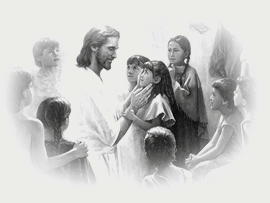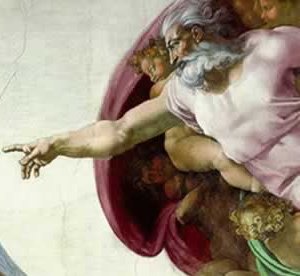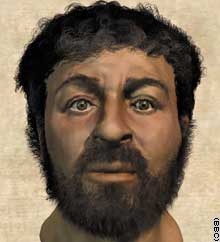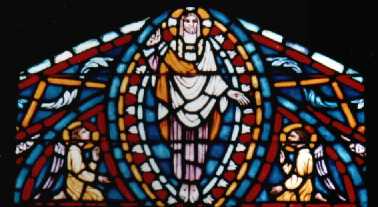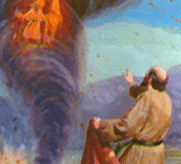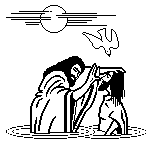On this page, I will try to explain some basic Christian beliefs that may be of
interest to children and teens. But I don't want to "talk down" to you. If we
ask how the center of Christianity ended up in Rome rather than the birthplace
of Jesus, the explanation involves a complicated series of historical events.
You might need an adult to make sense of the vocabulary. No personal
information is requested here, but parents of minors may wish to review the
privacy policy.
Jesus Loved Children
It is widely held that Jesus loved children. Jesus says in the Gospels,
particularly Mark 10:14, "Suffer the little children to come unto Me..." Like
all Biblical verses, this is a translation from the languages Jesus and the
Apostles spoke. Most likely, they spoke Aramaic and Hebrew. When an English
translation of the Bible uses the word "suffer", it doesn't mean "in pain".
This use of that word simply means that Jesus tells His disciples to "let"
little children come to Him. Jesus was kind and gentle and we believe that
children would have enjoyed being near to Jesus.
The Bible and most traditional Christian texts refer to God as "The Father", so
there is much evidence that we view ourselves as God's children.
Is God a man?
Traditionally, God has been referred to as a male figure, and certainly, Jesus
lived on earth as a human male. However, we don't exactly know the true nature
of God. God is not usually present in a material form for us while we are
alive. God is with us, but not like our Mom is with us.
All people have a father and a mother, even if all the family members don't
live together in one home. In some cases, your father could have died before
you were born, and in some cases you might not know your natural mother and
father, but you still must have had a father and mother. The mother of Jesus
was Mary (Luke 2). Mary carried Jesus in her belly just like all babies are
carried in a mother's belly before birth. Mary was a woman, so she was the
"mother" of Jesus. If Jesus was a human, then he also must have had a father.
If the father of Jesus was God, was God a man?
Well, no. We can say that God acted as the father of Jesus, but we still don't
know the true nature of God. Whatever God is, God is not a human being. Jesus
lived as a human on earth, but ascended to heaven to continue to be part of
God. Even though God knows what it is like to be human (because Jesus was human
for a time and Jesus is part of the Trinity that includes the God referred to
as the Father), God is not human. Even though God was able to be the father
that allowed Mary to carry Jesus in her belly, God is not a man. And God is not
a woman, either. God is a powerful being that created everything in the
universe. If it sounds like I don't know what I'm talking about, well, that's
about right. None of us can truly imagine the glory of God because we humans
are simply not as glorified as God.
Did Jesus have children?
There are some stories (outside the Bible) about Jesus having a family. We have
heard a lot about the novel The DaVinci Code by Dan Brown, and this book
states that Jesus got married and had kids. But this book is fictional; the
author made up the story. It's OK to write fiction, even about Jesus, but
fiction is not historical fact.
There is no direct evidence in the Bible (or any historical documents) that
Jesus had any children, and most Christians do not believe that Jesus had
children. But Jesus still loved kids!
Can we find the story about the Easter Bunny and Santa Claus in the Bible?
You won't find the Easter Bunny in the Bible, and Santa Claus is modeled after a
good man named Nicholas who lived long after the Bible was finished.
First, let's think about the early Christian church, during the first few centuries
after Jesus died on the cross and was resurrected. Before He died, Jesus called
his disciple Peter a "rock" on which Jesus would build His church (Matthew
16:18). In the early days of the church, many people felt that Jesus meant that
one person should lead the church. In general, we can think of Peter as the
first Pope, and members of the Roman Catholic church still believe that one
male should lead all Christians. Today, not all Christians believe this, so
many Christians belong to other denominations, such as Baptist or Episcopalian
(there are many more).
But back in those early days, when Christianity was first being defined and
passed on to others, and the chapters of the New Testament were being
collected, the Christian church was led by a small, core group (with one top
leader). And some of the things that had to be determined were how to celebrate
the major events of Christianity. For example, should we celebrate the birth
and resurrection of Jesus? And since the Bible doesn't directly say that
Christmas comes on December 25, when should it be celebrated?
Remember also that Jesus lived in what is now called Israel, and it took
centuries for Christian beliefs to spread around the world. The people who were
to become Christian were often pagans, meaning that they didn't worship one
god, but mainly worshipped the earth and the seasons. However, the idea of a
single, loving Creator spread, and this idea (known as monotheism) is practiced
by Jews, Muslims and followers of other faiths.
In many cases, early church leaders scheduled the Christian holidays around the
times that the non-Christians were already celebrating other holidays. This
might seem like a trick, but it really just made it simpler for people to learn
about Jesus.
Christmas on December 25 is held around the time of the winter solstice (the shortest day
of the year in the northern hemisphere). Easter is timed according to the
Jewish Passover, and this happens to occur in the springtime, and the
springtime is associated with new birth and growth. And if you know anything
about bunnies, it's that they have lots of babies. Eggs, too, are a symbol of
birth (and therefore springtime). So even though there are no bunnies handing
out colored eggs in the Bible, they have become associated with Easter. It's OK
to color eggs, but also try to remember the real meaning of Easter. "Alleluia,
the Lord is Risen. The Lord is Risen indeed. Alleluia."
What did Jesus look like?
Remember that when Jesus lived, the Roman Empire ruled most of the civilized
world. There were small groups of humans in various parts of the world who were
simple farmers and hunters who didn't know the Romans, but most people were
subject to the rule of the Roman emperor and Roman armies. As a result, the
center of civilization, and the centers of art and culture and education, were
all in Rome. So, it should be no surprise that the center of Christianity
migrated from the Middle East to Rome.
At first, art was not important in Christianity. In fact, Christians were
persecuted (treated badly) in the first years after Jesus died. In those early
years, if you carried around a picture of Jesus, you could be identified as a
Christian and you could be attacked. Christians used secret symbols such as a
fish symbol (icthus), rather than actual pictures of Jesus. The use of a fish
symbol is related to the saying that Jesus is a "fisher of men and women",
meaning that Jesus "catches" us and shows us a great path for life. If anyone
ever did paint an actual picture of Jesus while Jesus was on earth, the picture
certainly did not survive, so there is no way for us now to truly know what
Jesus looked like.
Eventually, the Roman empire fell. Not only did persecution
of Christians end, but Christianity became one of the world's major religions.
It then became safe to paint pictures of Jesus, but the center of Christianity
was still Rome. The painters wanted Jesus to look great, but human, and those
human painters were descended from Roman pagans, not from Palestinian Jews! As
a result, the popular images of Jesus we most often see in Europe and North
America make Jesus look, well, European (like in the picture at the top of this page).
That's OK, but probably not what a man from Nazareth would have looked like. A
modern artist named Richard Neave used historical and archeological records to
simulate what a Palestinian might have looked like in the 1st Century A.D.
What about art and music in Christian churches?
A few hundred years after the resurrection, the centralized organization of the
Christian movement was taking root, persecution had subsided as noted above,
and the use of art became more prevalent. But a thousand years later, the use
of art had become so prevalent that the issue became one of many complaints
against the Church during the Protestant Reformation. Many non-Catholic
denominations considered art and music a distraction from worship and from
their daily work. Drawing pictures and singing for fun were viewed as sinful,
and even church singing was limited to voices (no instruments) and a small
number of melodies. This may sound strange to us in the 21st Century, but it
took another couple of centuries, into the 1800s, before Protestant churches
began to encourage singing and instruments such as organs. Roman Catholic music
and art also flourished.
In the previous paragraph, you may have heard all the words before, but think of
what they mean. In the 15th Century, Martin Luther and others felt that certain
practices of the Roman Catholic church needed to be "reformed", and this is
where we get the word "Reformation". The Lutheran denomination is named after
Martin Luther. The people who protested against the practices of the Roman
Catholic church continue to be referred to as Protestants. There were many
complaints having to do with the way the Roman Catholic church collected money
and handled the forgiveness of sin (and more). Most of these complaints have
been addressed in our modern times, so I don't mean for this essay to seem
negative toward Roman Catholics, and of course, most Christians are Roman Catholics.
Do our bodies go to heaven?
There are a number of stories in the Bible in which a living person ascends to
heaven, including Jesus and His mother Mary. It is unclear if Moses' body
ascended to heaven; Scripture says that God buried Moses in an unknown place
(Deuteronomy 34:6). In this drawing we see the prophet Elijah riding a chariot
of fire to heaven (2 Kings 2:11).
However, we typically do not think of being raised bodily to heaven, and it's
hard to imagine what heaven is like for the few prophets and saints whose
bodies ascended. Our souls leave our mortal bodies behind, and this allows us
to experience paradise without earthly burdens.
When should I be baptized?
I was a Christian for many years before becoming aware of the level of controversy surrounding this question.
Many Christian denominations baptize infants and then provide a "confirmation" ceremony
for older youths, while other denominations baptize only those mature enough to ask for the baptism.
My personal feeling is that a person cannot really make an educated decision about religion until he or
she has left home and experienced the world, so I do not see much difference between baptizing an infant
or an adolescent. I brought up my own kids as Christians, and they are baptized and confirmed, and I think
that's great, but I can't really claim they made fully educated choices independent of their upbringing.
